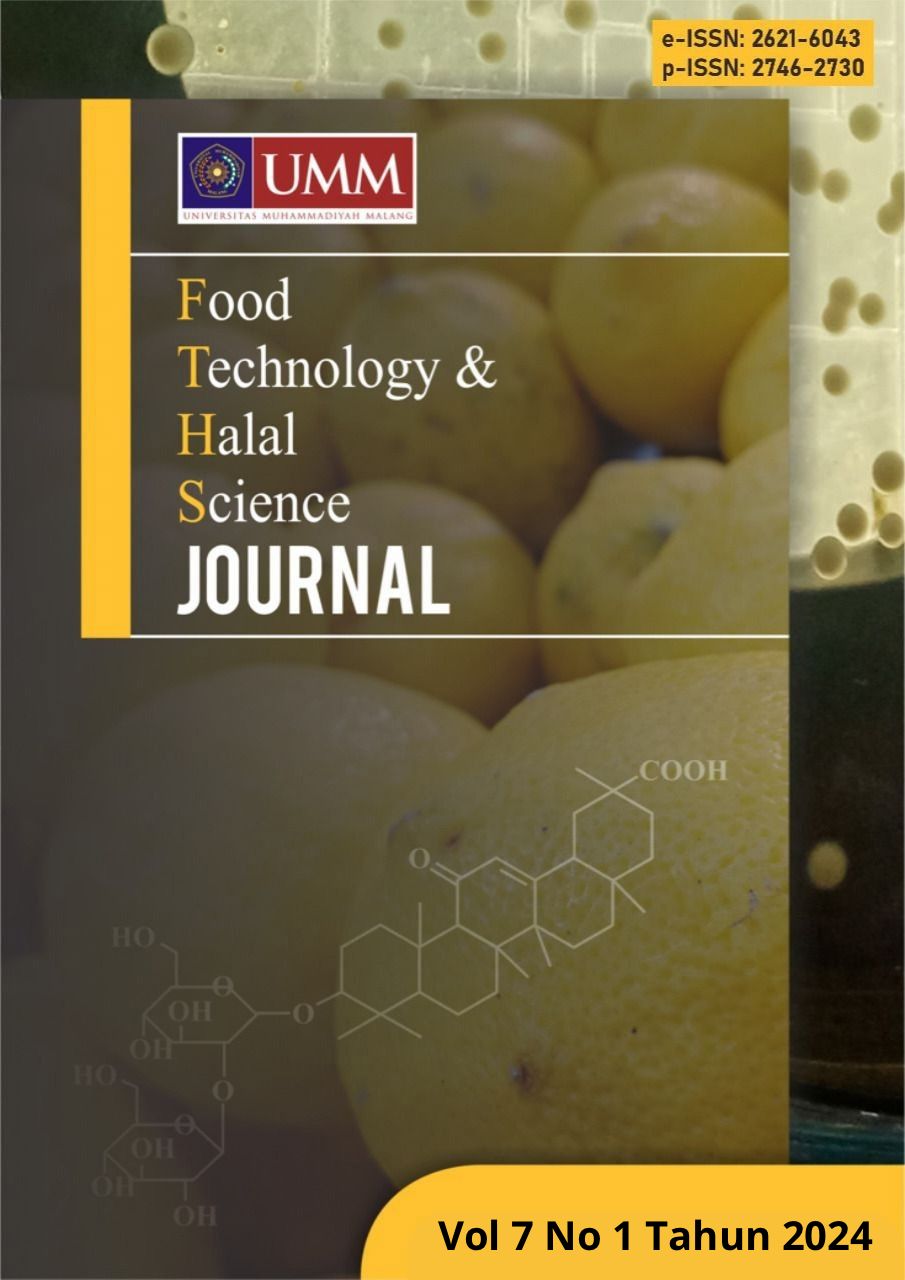Studi Karakteristik Fisik Isolat Asam Glutamat Melalui Proses Asidifikasi dengan Variasi Suhu dan Waktu
DOI:
https://doi.org/10.22219/fths.v7i1.28397Keywords:
pH isoelektrik, Hakko Broth, Standar Aji CoAbstract
Asidifikasi dibutuhkan dalam menghasilkan isolat asam glutamat agar sesuai dengan Standar Aji Co. Asidifikasi adalah penurunan pH dengan penambahan asam sulfat (H2SO4) pada hasil fermentasi tetes tebu (Hakko Broth) hingga mencapai pH Isoelektrik. Pengontrolan suhu Hakko Broth dan waktu asidifikasi hingga proses seeding masih belum dilakukan pada beberapa industri yang memproduksi MSG. Tujuan penelitian ini adalah menghasilkan isolat asam glutamat yang sesuai dengan Standar Aji Co dengan memberikan kontrol pada suhu Hakko Broth dan waktu saat proses asidifikasi hingga proses seeding. Penelitian ini dilakukan di PT Ajinomoto Indonesia dengan mengikuti SOP di sana dan sesuai Standar Aji Co. Rancangan penelitian ini eksperimental deskriptif. Sampel yang digunakan yaitu Hakko Broth merupakan hasil dari proses fermentasi tetes tebu. Terdapat 3 perlakuan sampel yaitu A1, A2, dan A3. Parameter analisis dari penelitian ini disesuaikan dengan Standar Aji Co, antara lain kadar asam glutamat yang akan terbuang bersama pengotor, kelarutan kristal isolat asam glutamat pada pH Isoelektrik, bentuk, dan ukuran asam glutamat. Hasil dari penelitian menunjukkan bahwa perlakuan A1 merupakan perlakuan terbaik karena menghasilkan paling sedikit kadar asam glutamat yang terbuang dan memenuhi Standar Aji Co, yaitu 1,97 g/dL. Kelarutan kristal isolat asam glutamat paling rendah pada pH Isoelektrik dimiliki oleh perlakuan A1. Kristal isolat asam glutamat yang dihasilkan dari proses asidifikasi ini memiliki struktur α-asam glutamat dengan ukuran yang heterogen pada semua perlakuan, namun perlakuan A1 memiliki ukuran kristal yang paling homogen di antara perlakuan lainnya.
Downloads
References
Anggraini, I., Ferniah, R. S., & Endang, K. 2019. Isolasi Khamir dari Batang Tanaman Tebu dan Identifikasinya Berdasarkan Sekuens Internal Transcribed Spacer. Jurnal Bioteknologi Dan Biosains Indonesia, 6 (1), pp. 39–52. DOI : https://doi.org/10.29122/jbbi.v6i1.3276
Cashell, Corcoran, & Hodnett. 2004. Control of polymorphism and crystal size of L-glutamic acid in the absence of additives. Journal of Crystal Growth, 273 (1), pp. 258–265. DOI : https://doi.org/10.1016/j.jcrysgro.2004.08.020
Djohar, M. A., Timbowo, S. M., & Mentang, F. 2018. Tingkat Kesukaan Panelis Terhadap Penyedap Rasa Alami Hasil Samping Perikanan Dengan Edible Coating Dari Karagenan. Jurnal Media Teknologi Hasil Perikanan, 6 (2), pp. 37–41. DOI : https://doi.org/10.35800/mthp.6.2.2018.19507
Hirayama, N., Shirahata, K., Ohashi, Y., & Sasada, Y. 1980. Structure of α Form of L-Glutamic Acid α-β Transition. Bulletin of the Chemical Society of Japan, 53 (1), pp. 30–35. DOI : https://doi.org/10.1246/bcsj.53.30
Julianto, G., Ustadi, & Husni, A. 2011. Karakterisasi Edible Film dari Gelatin Kulit Nila Merah dengan Penambahan Plasticizer Sorbitol dan Asam Palmitat. Journal of Fisheries Sciences, 13 (1), pp. 27–34. DOI : https://doi.org/10.22146/ jfs.3059
Kee, N., Tan, R., & Braatz, R. 2009. Selective Crystallization of the Metastable α-Form of Glutamic Acid using Concentration Feedback Control. Crystal Growth dan Design, 9 (7), pp. 3044–3051. DOI : https://doi.org/10.1021/cg800546u
Kitamura, M. 1989. Polymorphism in the crystallization of L-glutamic acid. Journal of Crystal Growth, 96 (3), pp. 541–546. DOI : https://doi.org/10.1016/0022-0248(89)90049-3
Kusnandar, F. 2020. Kimia Pangan Komponen Makro. Jakarta : PT Bumi Aksara.
Kusuma, E. W., Larasati, A., Nurkhamidah, S., & Altway, A. 2020. Pra Desain Pabrik Poly-L-Lactic Acid dari Tetes Tebu. Jurnal Teknik ITS, 8 (2), pp. 139–144. DOI : https://doi.org/10.12962/j23373539.v8i2.46997
Lindenberg, C., & Mazzotti, M. 2009. Effect of temperature on the nucleation kinetics of α l-glutamic acid. Journal of Crystal Growth, 311 (4), pp. 1178–1184. DOI : https://doi.org/10.1016/j.jcrysgro.2008.12.010
Naufal, A., Kusdiyantini, E., & Raharjo, B. 2017. Identifikasi Jenis Pigmen Dan Uji Potensi Antioksidan Ekstrak Pigmen Bakteri Serratia marcescens Hasil Isolasi Dari Sedimen Sumber Air Panas Gedong Songo. Jurnal Bioma, 19 (2), pp.95–103. DOI : https://doi.org/10.14710/bioma.19.2.95-103
Petrucci, R., Harwood, W., Herring, G., & Madura, J. 2011. General Chemistry: Principles and Modern Applications (9th ed.). Jakarta : Erlangga.
Riskesdas. 2018. Potret Sehat Indonesia dari Riskesdas. Jakarta: Kementrian Kesehatan RI.
Riwayati, I., Anam, A. C., & Maharani, F. 2020. Pengaruh Suhu dan Waktu Proses Modifikasi Heat Moisture Treatment (HMT) pada Tepung Kulit Singkong terhadap Sifat Kelarutan dan Swelling Power. Jurnal Inovasi Teknik Kimia, 5 (1), pp. 57-65. DOI : https://doi.org/10.31942/inteka.v5i1.3402
Santos, D. O., Coimbra, J. S. R., Teixeira, C. R., Barreto, S. L. T., Silva, M. C. H., & Giraldo, A. D. 2015. Solubility of Proteins from Quail Egg White as Affected by Agitation Time, pH, and Salt Concentration. International Journal of Food Properties, 18 (2), pp. 250–258. DOI : https://doi.org/10.1080/10942912.2012. 654557
Wahyudi, B., & Muljani, S. 2019. Pupuk Mulnutrient Berbasis Silika dari Limbah Geothermal Sludge dengan Proses Asidifikasi. Jurnal Teknik Kimia, 14(1), pp. 22–27. DOI : https://doi.org/10.33005/jurnal_tekkim.v14i1.1651
Downloads
Published
How to Cite
Issue
Section
License
Copyright (c) 2024 Putri Kirana Maharani, Vritta Amroini Wahyudi, Warkoyo Warkoyo

This work is licensed under a Creative Commons Attribution 4.0 International License.
Authors who publish with this journal agree to the following terms:
- Authors retain copyright and grant the journal right of first publication with the work simultaneously licensed under a Creative Commons Attribution License that allows others to share the work with an acknowledgement of the work's authorship and initial publication in this journal.
- Authors are able to enter into separate, additional contractual arrangements for the non-exclusive distribution of the journal's published version of the work (e.g., post it to an institutional repository or publish it in a book), with an acknowledgement of its initial publication in this journal.
- Authors are permitted and encouraged to post their work online (e.g., in institutional repositories or on their website) prior to and during the submission process, as it can lead to productive exchanges, as well as earlier and greater citation of published work (See The Effect of Open Access).










